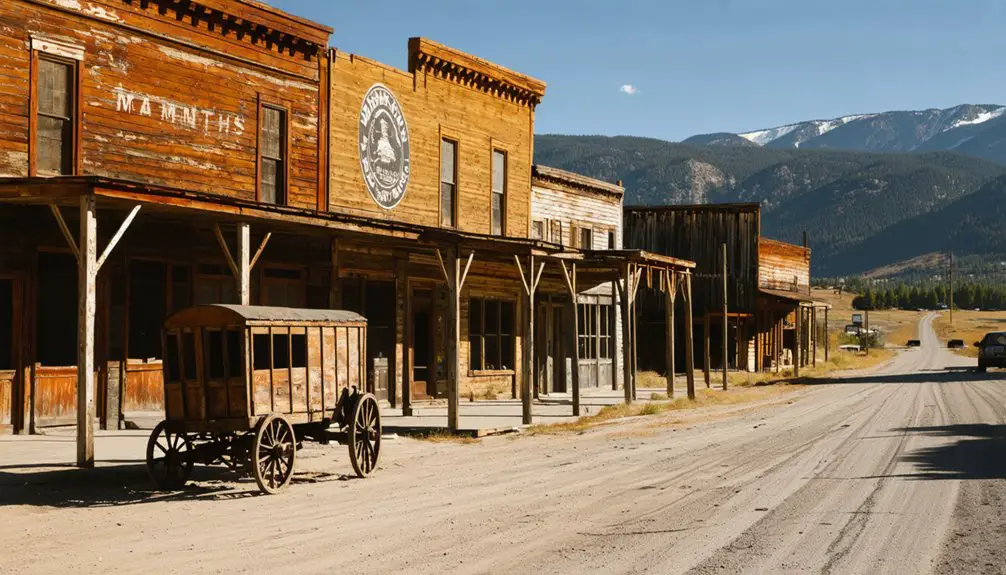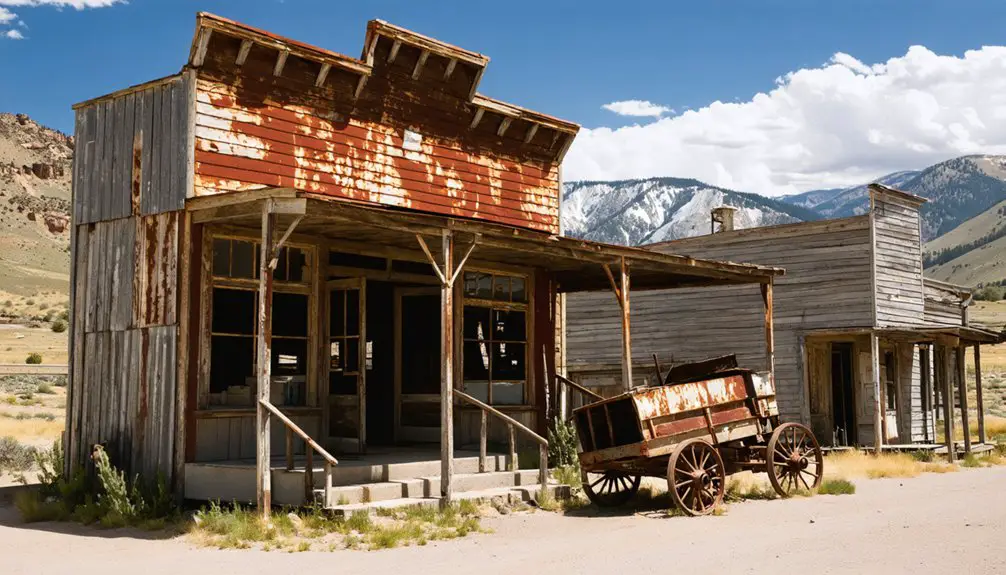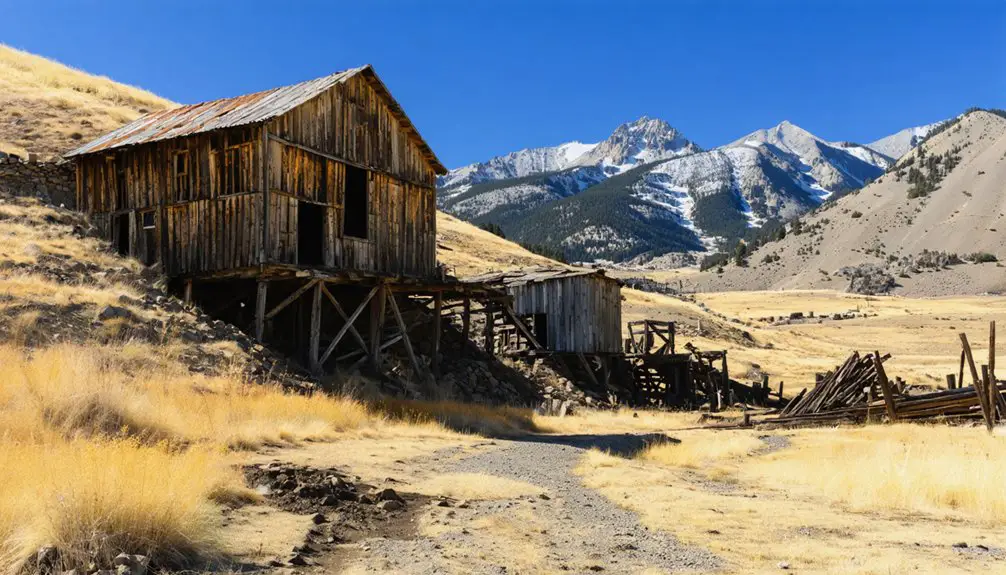You’ll find Mammoth’s crumbling ruins in Utah’s Tintic Mountains, where Charles Crimson first discovered rich mineral deposits in 1870. The town flourished between 1900-1910, reaching nearly 3,000 residents as silver, gold, and lead mining operations thrived. Despite its incorporation and merger with Robinson in 1910, Mammoth couldn’t survive the Great Depression and declining ore yields. Today, archaeological remnants like the Hotel Mammoth’s foundation reveal fascinating glimpses into this once-bustling mining community’s pioneering spirit.
Key Takeaways
- Mammoth was a thriving Utah mining town discovered in 1870 that produced gold, silver, lead, copper, and bismuth until its decline.
- The town peaked between 1900-1910 with nearly 3,000 residents, four large hotels, and a school serving 477 children.
- Economic decline began with falling metal prices, leading to mine closures and population decrease to 750 residents by 1930.
- Water scarcity was a major challenge, with drinking water costing 10 cents per gallon throughout the town’s existence.
- Today, Mammoth stands as a ghost town with remaining foundations and artifacts that showcase Utah’s rich mining heritage.
The Discovery That Started It All
As prospectors scoured Utah’s mineral-rich landscape in the late 1800s, they struck upon what would become the Mammoth Mine on February 26, 1870. This momentous discovery coincided with the settlement of nearby Eureka, marking the beginning of significant mining discoveries throughout the region.
You’ll find that the early days weren’t easy for these determined pioneers. Water scarcity and harsh conditions slowed initial growth, but the promise of silver, gold, lead, and copper drew persistent settlers from diverse backgrounds.
German, Irish, Welsh, and Cornish miners flocked to the area, bringing their expertise to this challenging frontier. Despite settlement challenges like having to purchase drinking water at premium prices, the Mammoth Mine’s rich output lived up to its name and established the foundation for a thriving mining community. The McIntyre brothers made a pivotal investment when they traded their cattle for mine shares, though a harsh winter later decimated their herd. The initial claim belonged to Charles Crimson, who made the first ore discovery before trading the property to the McIntyres.
Early Settlement and Mining Operations
While the Mammoth Mine’s initial discovery marked a pivotal moment in Utah’s mining history, the settlement’s early development progressed gradually under challenging conditions.
You’ll find that settlement patterns emerged as German, Irish, Welsh, and Cornish immigrants established their homes in this remote location, despite the scarcity of water that forced residents to purchase drinking supplies.
The mining techniques evolved notably after Charles Crismon traded his majority stake to the McIntyre brothers in 1873.
They implemented deeper shaft-sinking methods to access rich ore bodies containing gold, silver, lead, copper, and bismuth. The mine’s high-quality gold would later grace the Utah State Capitol building.
Through strategic development and persistent operations, the McIntyres established a foundation for what would become 75 years of productive mining activity. The Tintic Mill was constructed near McIntyre’s ranch to process the extracted ore. The town reached its peak with four large hotels and a school during the most prosperous period of mining operations.
Transportation and Infrastructure Growth
The expansion of Utah’s railroad networks in the 1870s marked a transformative period for Mammoth’s development. The Utah Central line connecting Ogden to Salt Lake City, along with pivotal branch lines to mining districts, established critical transportation networks that you would’ve relied on for survival in this remote settlement. The Tintic Mining District emerged following the arrival of the transcontinental railroad, revolutionizing ore transportation in the region. When the Lucin Cutoff opened in 1902, it dramatically altered transportation routes throughout Utah.
You’d have faced significant infrastructure challenges in Mammoth, particularly regarding water access. With no local water sources, you would’ve depended on costly transported drinking water and elaborate piping systems for mining operations.
The town’s connection to neighboring settlements like Eureka and Robinson became essential for goods and services. While larger cities enjoyed streetcar systems, Mammoth’s infrastructure remained focused on mining necessities, including the Tintic Hospital and hotels that supported the growing workforce of up to 3,000 residents.
Life in a Thriving Mining Community
Walking through Mammoth during its peak years, you’d find a bustling commercial district with stores and saloons serving both local residents and mine workers.
When the Denver & Rio Grande Western railroad arrived in 1891, the town experienced remarkable growth and development.
The town’s social scene centered around prominent establishments like the Hotel Mammoth, where travelers and locals gathered for entertainment and community events.
Located in the East Tintic Mountains, Mammoth provided abundant mineral resources that sustained the community for generations.
Despite the harsh conditions and remote location, Mammoth’s diverse immigrant population created a rich cultural atmosphere, blending German, Irish, Welsh, and Cornish traditions in their daily life and celebrations.
Daily Commerce and Trade
Bustling streets of Mammoth, Utah once echoed with the daily rhythms of commerce driven by its thriving mining operations.
You’d find a vibrant local trade ecosystem where gold, silver, lead, and copper extraction fueled the town’s economy for 75 years. Mining commerce touched every aspect of daily life, from the ten-cent water sales to the four large hotels accommodating the stream of workers and visitors.
The town’s peak population of nearly 3,000 residents supported a diverse marketplace. Early reports showed mines producing eight dollars per ton in valuable ore during peak operations.
You’d see freight wagons hauling precious ore, workers filing in and out of bunkhouses, and merchants supplying essential tools and provisions.
Even early business deals reflected the town’s resourceful spirit – in 1873, cattle were traded for mine shares, demonstrating how mining shaped every commercial transaction in this industrious community.
Social Entertainment Culture
Despite harsh working conditions in Mammoth’s mines, residents forged a vibrant social fabric woven from diverse cultural threads.
You’d find miners from German, Irish, Welsh, and Cornish backgrounds sharing stories at local saloons or attending social gatherings at the renowned Hotel Mammoth. Cultural traditions merged as immigrant families brought their customs, dialects, and celebrations to this bustling town of 2,500-3,000 residents.
The LDS ward and schoolhouse served as anchors for community events, while four large hotels hosted dances and visiting performers.
After grueling shifts in the mines, you could unwind at one of several saloons or join outdoor activities like community picnics.
The railroad’s arrival in 1891 connected you to neighboring communities, expanding social networks and entertainment options beyond Mammoth’s borders.
Peak Years and City Incorporation

During its peak years between 1900 and 1910, Mammoth transformed from a mining camp into an incorporated city with a population that swelled to nearly 3,000 residents.
The town’s growth coincided with thriving silver, gold, and lead mining operations that attracted families and workers seeking opportunity in Utah’s Tintic Mining District.
In 1910, Mammoth officially merged with the neighboring camp of Robinson, establishing a formal city government.
You’ll find evidence of the town’s significance in its 1909 school enrollment of 477 children and robust infrastructure that included four hotels and various businesses.
Just as woolly mammoths went extinct around 10,000 years ago in mainland Siberia, the town of Mammoth would face its own decline in later years.
However, population trends began shifting after 1912, dropping to 1,700 residents as fires, water scarcity, and labor disputes challenged the community.
The Rise and Fall of Robinson
When Robinson laid out his namesake townsite in the mid-1890s, he established what would become the residential counterpart to neighboring Mammoth’s business district.
The Robinson community, though technically separate, grew so close to Mammoth that their boundaries merged, creating what locals called Uppertown and Lowertown.
The mining influence shaped Robinson’s development in several key ways:
- Two significant mills – the Mammoth mill and Farrell/Siox mill – provided industrial employment
- The McIntyre brothers exercised considerable control, eventually dismissing Robinson himself for eccentric behavior
- Residential growth flourished as mining operations expanded in the area
Despite its initial promise, Robinson’s fate was tied to the mines.
As mining declined, the town struggled to maintain its population, ultimately succumbing to the same economic forces that claimed many Western mining communities.
Economic Challenges and Population Decline

You’ll find that Mammoth’s economic fate was inextricably tied to its mining industry, which sustained the town for approximately 75 years until declining ore yields and fluctuating metal prices led to its eventual crash.
The harsh realities of the mining economy, including expensive drinking water at 10 cents per gallon and limited economic diversification, created significant hardships for the town’s residents.
These challenges, combined with the onset of the Great Depression in 1929, triggered a mass exodus that reduced Mammoth’s population from its peak of 2,500-3,000 residents to just 750 by 1930.
Mining Industry Crash
The steep decline in silver and lead prices during the early 1890s devastated Mammoth’s mining-based economy, triggering a cascade of mine closures throughout the Tintic District.
Mining profitability plummeted as ore values dropped to just $8.00 per ton by 1931, making large-scale operations unsustainable. The impact of this resource depletion and market crash rippled through the entire community.
Key effects of the mining industry collapse included:
- Sharp population decline from 2,500-3,000 residents to just 750 by 1930
- Reduced investment capital for equipment maintenance and modernization
- Closure of essential infrastructure, including mills and railroad connections
The crash forced Mammoth to disincorporate in 1929, with remaining residents resorting to small-scale mining or subsistence activities.
The once-thriving mining hub rapidly transformed into another Western ghost town.
Labor Strikes Impact
Labor unrest and strikes during the early 1900s dealt devastating blows to Mammoth’s already fragile mining economy. As immigrant miners, who formed the backbone of labor unions, fought for better wages and safer working conditions, they faced severe economic hardship.
The strikes often dragged on for months, leaving families without income while company stores offered no relief.
You’ll find that these prolonged labor disputes triggered a significant exodus from Mammoth. Many immigrant families, faced with mounting financial pressures and blacklisting by mining companies, were forced to seek work elsewhere.
The mining companies’ refusal to negotiate with unions, combined with their use of strikebreakers, created deep social rifts within the community. This unstable environment contributed to Mammoth’s declining population and eventual transformation into a ghost town.
Exodus of Residents
Relentless economic pressures gradually emptied Mammoth of its once-thriving population between 1910 and 1930. As mining operations became less profitable, you’ll find that migration patterns show a dramatic decline from 1,828 residents to just 750 people.
The town’s community resilience was tested by multiple challenges that forced families to seek opportunities elsewhere:
- The closure of mines eliminated jobs while rising water costs of ten cents per gallon strained household budgets
- Devastating fires in 1912, 1926, and 1928 destroyed essential businesses and infrastructure
- Legal battles reduced city boundaries in 1925, crippling tax revenue needed for basic services
The Ghost Town’s Lasting Heritage

While Mammoth’s once-bustling streets have fallen silent, its lasting heritage continues to offer invaluable insights into Utah’s mining era through archaeological findings and architectural remnants.
You’ll find cultural preservation efforts revealing a rich tapestry of immigrant life, with artifacts from German, Irish, Welsh, Cornish, and Chinese residents painting a picture of remarkable diversity.
The archaeological significance extends beyond mere foundations and tools – you’ll discover Chinese currency, porcelain fragments, and distinct food remains that document previously overlooked contributions to the community.
Today’s remnants, including the Hotel Mammoth foundations and historic water pipeline infrastructure, stand as evidence to the engineering feats and daily life of this 75-year mining operation that shaped Utah’s industrial landscape.
Frequently Asked Questions
Are Any Original Mining Equipment or Artifacts Still Visible at the Site?
You’ll find preserved mining artifacts both underground and on the surface, though most equipment’s been removed. Underground workshops still house original tools, while surface areas reveal historical building foundations and fragments.
What Safety Precautions Should Visitors Take When Exploring Mammoth’s Ghost Town?
While you’re free to explore this ghost town’s historic charm, don’t skimp on safety gear. Bring sturdy boots, flashlights, first aid supplies, water, and always explore with others, avoiding unstable structures.
Is the Mammoth Mine Site Accessible to the Public Today?
No, you can’t legally access the Mammoth mine site today. It’s on private property and has been sealed by Utah’s Abandoned Mine Reclamation Program for safety. Nearby OHV trails don’t grant mine access.
What Happened to the Water Pipeline System From Jenny Lynn Spring?
You’d be thrilled to know this monument to water conservation fell into disrepair and disappeared after mining declined in the 1890s, though its historical significance lives on through scattered wooden remnants.
Did Any Famous Outlaws or Notable Historical Figures Visit Mammoth?
You won’t find records of famous outlaws or notable historical figures visiting Mammoth, though local saloons and the Hotel Mammoth could’ve hosted unnamed drifters passing through this bustling mining town.
References
- https://beyond.nvexpeditions.com/utah/juab/mammoth.php
- https://westernmininghistory.com/towns/utah/mammoth/
- https://www.oocities.org/ut_ghost/tintic/mammoth/mammoth.html
- https://www.youtube.com/watch?v=brCXNENu9D4
- https://www.youtube.com/watch?v=GaHW9gpkKqA
- http://utahspresenthistory.blogspot.com/2011/04/old-glory-hole.html
- https://utahrails.net/mining/mammoth-mine-tintic.php
- https://historytogo.utah.gov/railroads-utah/
- https://www.ksl.com/article/50263094/a-history-gold-mine-excavations-from-utah-ghost-town-uncover-important-artifacts
- https://www.youtube.com/watch?v=wOPRA2uDm24



